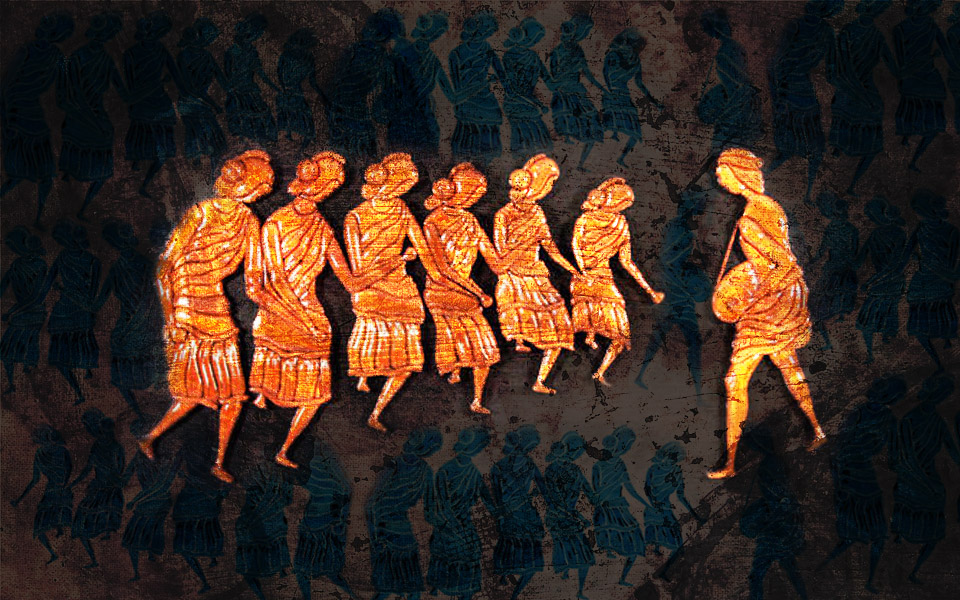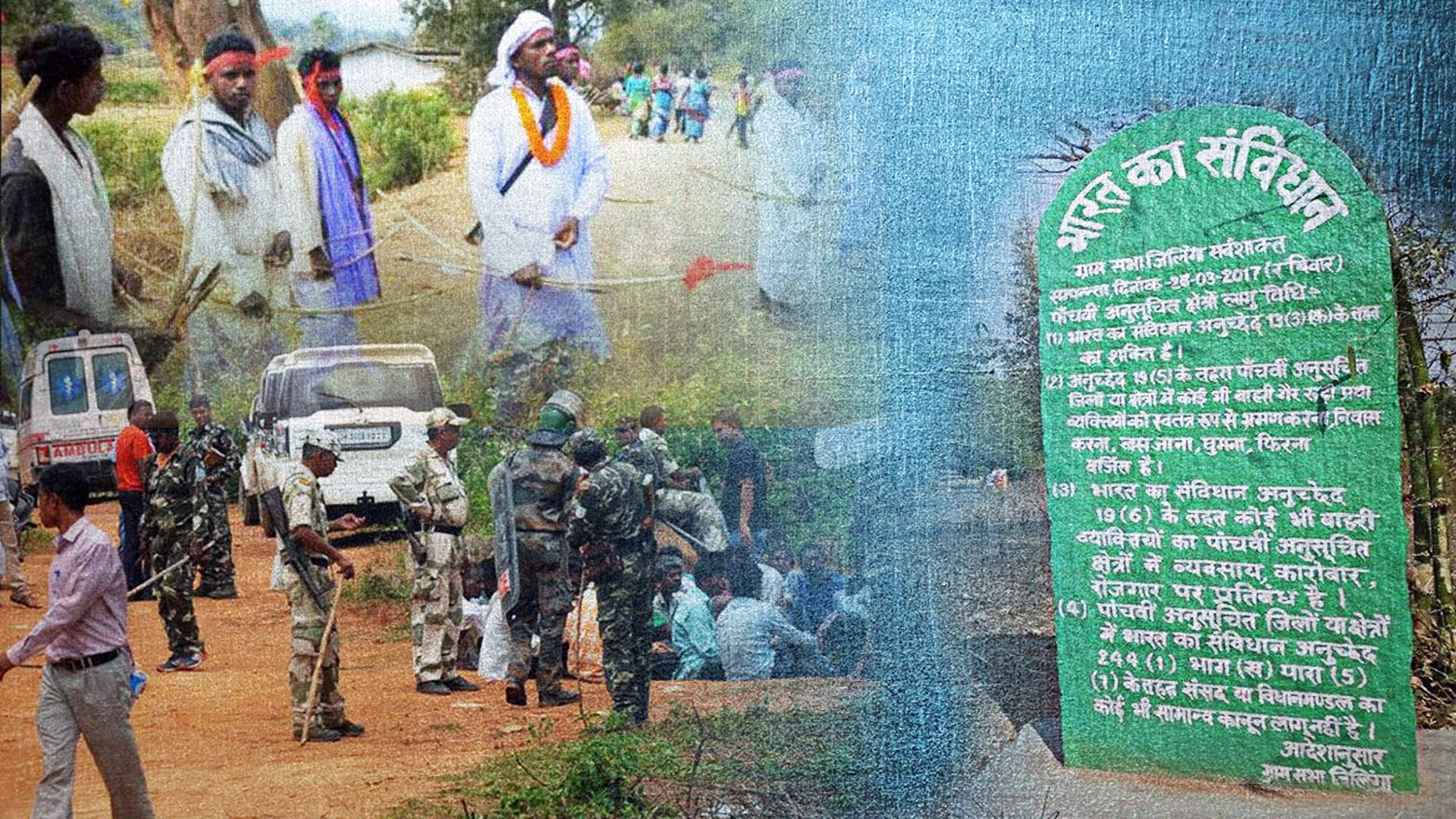
- Home
- News
- Analysis
- States
- Perspective
- Videos
- Education
- Entertainment
- Elections
- World Cup 2023
- Features
- Health
- Business
- Series
- Economy Series
- Earth Day
- Kashmir’s Frozen Turbulence
- India@75
- The legend of Ramjanmabhoomi
- Liberalisation@30
- How to tame a dragon
- Celebrating biodiversity
- Farm Matters
- 50 days of solitude
- Bringing Migrants Home
- Budget 2020
- Jharkhand Votes
- The Federal Investigates
- The Federal Impact
- Vanishing Sand
- Gandhi @ 150
- Andhra Today
- Field report
- Operation Gulmarg
- Pandemic @1 Mn in India
- The Federal Year-End
- The Zero Year
- Premium
- Science
- Brand studio
- Home
- NewsNews
- Analysis
- StatesStates
- PerspectivePerspective
- VideosVideos
- Entertainment
- ElectionsElections
- Sports
- Loading...
Sports - Features
- BusinessBusiness
- Premium
- Loading...
Premium

Target tribals: the BJP's strategy in Jharkhand
In Jharkhand, anecdotal evidence shows that many tribals vote for the BJP. The saffron partys vote share has been increasing over the years.

A feature of the Lok Sabha poll results was that regions that were traditional outliers for the BJP voted for the party. The party was able to sweep the north-east, for instance. But there were holdouts, and one among them was the tribal-dominated two seats of Jharkhand. Elsewhere in Jharkhand, however, anecdotal evidence shows that many tribals did vote for the BJP. The BJP government that...
A feature of the Lok Sabha poll results was that regions that were traditional outliers for the BJP voted for the party. The party was able to sweep the north-east, for instance. But there were holdouts, and one among them was the tribal-dominated two seats of Jharkhand.
Elsewhere in Jharkhand, however, anecdotal evidence shows that many tribals did vote for the BJP. The BJP government that came to power in 2014 in the state has wooed tribals with various projects. “In the past four and a half years, we have done a lot for tribals. We have introduced a domicile policy, due to which 90 per cent of the jobs have gone to natives (tribals and non-tribals),” Praful Shahdev, BJP spokesperson for Jharkhand, told The Federal. Assembly elections are scheduled for November this year and the Sangh Parivar has already started its ground work in Jharkhand.

A key part of the campaign is to counter the influence of the church. “For a long time, they have been trying to Hindu-ise and Sankritize tribals,” Jean Dreze, an academician, economist and tribal rights activist told The Federal. In a recent incident, Prakash Lakra, a 50-year-old Adivasi of Jurmu village in Dumri block was lynched to death by cow vigilantes from the neighbouring Jairagi village, setting off a stream of protests and creating resentment.
“For a long time, they have been trying to Hindu-ise and Sankritize tribals,” said Jean Dreze.
A new battleground in Jharkhand
The political battle in Jharkhand began in 2000, when the state was formed from 18 districts of Bihar. This was after over 50 years of agitation by Adivasis or tribals for a separate land due to their distinct culture. It was then that the 28th state, with over 8.6 lakh tribals, gained the attention of national parties including the BJP.
The saffron party has been increasing its presence in the state since 2004, when the party won just one seat in the Lok Sabha polls. A decade later, however, the BJP came the closest to winning all the seats, which no party has won in the state’s history. The saffron party won 12 seats while the Jharkhand Mukti Morcha (JMM) won the remaining two.
In the recently concluded Lok Sabha elections too, the BJP’s tally remained the same. This seems to have forced the party to be more aggressive in securing the remaining tribal votes in the state. According to Census 2011, tribals constitute 26.3 per cent of the state population.
Attempts to saffronise tribals
One of the ways that the BJP has been trying to win tribal votes is by ‘culturally expropriating the tribal culture’, Xavier Dias, an Adivasi Rights activist, told The Federal. Dias alleges that the RSS workers in the state, over the past 40-50 years, have made Adivasis believe that they are Hindus even though tribals do not follow any religion. “In all the Hindu scriptures, the Scheduled Castes (SC) and Scheduled Tribes (ST) are referred to as outcastes. Then how do they suddenly becomes Hindus?” questions Dias.
Ashok Bhagat, secretary of Vikas Bharti, an NGO working for the upliftment of tribals in Jharkhand, alleges that the Santhal, the largest tribal group in the state, are a part of Sanatan Dharma family. “The very fact that they worship nature makes them a part of Sanatan Dharma family,” Bhagat said in an interview to ET Magazine.
Jharkhand Freedom of Religion Act
The religious conflict between tribals and the RSS becomes complex when the Church comes into the picture. There has been a conflict between the RSS and the Church in Jharkhand for over a decade.
The conflict between them intensified in 2017 after the state brought in an anti-conversion law — Jharkhand Freedom of Religion Act. Jharkhand became the sixth tribal-dominated state to put curbs on conversion. According to the Act, any person found guilty of conversion through force or allurement is liable for punishment that includes a jail term of three years and a fine of ₹50,000.
Rift among tribals over religion
Last year, when the BJP government in the state introduced amendments to the Chotanagpur Tenancy Act (CNT) 1908 and Santhal Paragana Land Tenancy (SPT) Act 1949, many tribals protested. The amendments aimed at giving the state government power to use farming land for other purposes such as business and even buy such lands from tribals for development purposes. The BJP, however, created a rift between Christians and Sarnas (tribals who follow Sarna religion that is centred around the worshiping of nature represented by trees), James Kujur, a member of Jharkhand Janadhikar Mahasabha (JJM), a social organisation for tribal and civil rights told The Federal.
Sarna religion is practised by 13 per cent of the Jharkhand population while Christianity is followed by 4.1 per cent of the population. At 68.5 per cent, Hinduism is the dominant religion in the state.
Kujur alleges that the BJP created a feeling among Sarnas that since Christians were more educated, they were reaping all the benefits from tribal welfare schemes and CNT Act. It is widely perceived that tribals who accepted Christianity are educated and the literacy rate is high among them. “The BJP tried to divide tribals through anti-conversion law. But the party’s big is to extract tribal land in Jharkhand,” said Dreze.
Jharkhand is one of the leading producers of mineral in the country as it is has a vast variety of minerals such as iron ore, coal, copper ore, mica, bauxite, graphite, limestone, and uranium.
BJP still popular among tribals
Despite this, it does appear that the tribals voted for the saffron party in substantial numbers. The party’s vote share in the state shot up to 50.96 per cent in 2019 Lok Sabha polls from 33 per cent recorded in 2014 general elections.
The party seems to have reached out to tribals across districts. Shahdev, the BJP spokesperson for Jharkhand, emphasizes the domicile policy. The new Domicile Policy stated that people living in Jharkhand since or before 1985 will be considered local inhabitants and avail all the facilities offered in the policy. In 2016, the Jharkhand government also reserved all Grade III and Grade IV state government jobs for people belonging to the Scheduled Tribe (ST) community in areas where they are a dominant population, Shahdev added.
Stating that the government has taken the initiative to uplift tribals, Shahdev said, “The government introduced Johar Yojana wherein tribals could get loans up to ₹4 lakh to carry out occupations that they have indulged in for years.”
The party has been able to gain tribal votes as the government has been giving contracts for construction of roads or infrastructure and good posts tribals in government offices, Sanjay Verma, chief of Taaza Khabar in Jharkhand, told The Federal. The move helped the BJP garner an image as the party who is working towards the upliftment of the tribes. This may have helped the BJP gain votes from tribal people, Verma added.
“It is difficult to analyse the 2019 Lok Sabha results in Jharkhand,” Dreze said. Even though they have voted for the BJP in the Lok Sabha, does not mean that they will vote for the saffron party in the state elections, he added. Tribal activists such as Dreze and Dias, however, stressed on the fact that there is resentment from tribals in certain areas.
The Pathalgadi movement
They were referring to the Pathalgadi movement where Adivasis in over 200 villages in Khunti and in some other districts of Jharkhand put up stone plaques declaring their gram sabha as the only sovereign authority.
The stone plaques, measuring 15 ft by 4 ft and painted green, include excerpts from the Panchayats (Extension to Scheduled Areas) Act, 1996 (PESA) as well as warnings to outsiders, prohibiting them from entering the village.

The movement was a reaction to the presence of security forces and local administration whom locals considered hostile. According to a fact finding team from Jharkhand Janadhikar Mahasabha (JJM), People’s Union for Civil Liberties, Women Against Sexual Violence and State Repression (WSS) and Adivasi Adhikar Manch, several FIRs have been filed against at least 150 named and thousands of unnamed villagers on frivolous cases. A few of them were booked even for sedition.
Denying such allegations, the BJP Spokesperson for Jharkhand said that the government is committed towards uplifting the tribals. “The Pathalgadi movement was carried out by anti-nationals and people who indulge in conversion. Our government came down heavily on them,” Shahdev added.
As a response the Lok Sabha elections, Adivasis who are a part of the Pathalgadi movement decided to boycott voting. “In the Lok Sabha elections 2019, over 3,500 tribals in these villages did not vote,” Verma said.
Crackdown on a movement
Over the past two years, the police arrested a number of top Pathalgadi leaders including Father Alfonso Aind, People’s Liberation Front of India area commander Bazi Samad alias Takla, Jonas Mundu, Ajob Sandi Purty and Ashish Longo. As a result, the movement seems to have lost its momentum and has largely petered out in many villages. “If one’s leader goes to jail how long will the movement have the same momentum?” asked Kujur.
“There is an attempt to diffuse resentment through some kind of harassment such as an FIR. These are targeted towards a select few but it impacts other people who are willing to stand up. For instance, in the Pathalgadi movement, a few tribal ministers spoke about it,” Dreze said.
In March 2019, Dreze too was detained along with two others by police in Jharkhand’s Garhwa district for organising a gathering about Right to Food without permission from authorities. His detention sparked a wave of outrage among many political figures and economists who condemned the act on social media, following which he was released. “There’s a climate of suppression and it’s quite serious. Under the BJP rule, it has become harder to find a place for public meeting or a chance of significant descent,” Dreze said.
Public protest against mob lynching
A large number of tribals, activists and concerned citizens from several districts protested against the lynching of four Adivasis — Prakash Lakra, Peter Kerketta, Belarius Minj and Janerius Minj — at Dumri on June 1.
According to a fact finding team of human rights, Verma told The Federal, four Adivasis were skinning a dead ox in Dumri village on April 10. The ox died and the owner gave it to them to carve it for its meat and its hide. While the Adivasis were doing so, they were attacked by a mob of about 35-40 persons from Jairagi village.
After being beaten for around three hours, the victims were dumped by the perpetrators in front of Dumri police station at midnight. But instead of immediately rushing the victims to a hospital, the police made them wait outside for hours. By the time they were taken to the local health centre, Lakra had already succumbed to his injuries.
While the victims kept saying that they were carving an ox that had died, the police filed an FIR against them and 20-25 unnamed persons of their village on charges of cow slaughter. The inaction of the police has further fueled their fears. “The people of the areas get scared when the mob lynchers are supported by the government officials,” Kujur said.
Eleven persons including Lakra have been lynched so far in Jharkhand, of whom nine were Muslims and the remaining two were Adivasis.
Election campaign begins
Despite such instances, the BJP leaders in the state seem to be focused on preparing for the upcoming state elections. Chief minister Raghubar Das on June 3 visited Dhaka village in Dumka district to lay the foundation of various projects. The village falls in Santhal Parganas region of Jharkhand that is traditionally a stronghold of its rival Jharkhand Mukti Morcha (JMM). The saffron party seems to have already began its campaign and this time the focus is on areas where its vote share was less.

